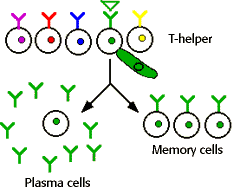
Introduction to Immunology Tutorial
Specific Protection: The Cellular System
The cellular system
- T-cells differentiate in the thymus, and have a specific receptor for a fragment of antigen..
- Cytotoxic T-cells contain a surface protein called CD8 and destroy pathogen
infected cells, cancer cells, and foreign cells (transplanted organs).
- Helper T-cells contain a surface protein called CD4 and regulate both the cellular
and humoral immune systems. This regulation reduces autoimmunity.
- Autoimmune disease- self immunity. Some examples include rheumatic fever,
rheumatoid arthritis, ulcerative colitis, myasthenia gravis, etc.
|
Immunological response
|
The graph shows a very important feature of the immune response. When first exposed to antigen "A",
we begin to make low levels of antibody in about a week However, a second exposure to antigen "A"
produces a much faster response,
and several orders of magnitude higher levels of antibody. The ability of antibody to
bind antigen also increases dramatically in the secondary response. Injecting a new antigen "B" with "A"
shows that a memory or prior exposure is required for the accelerated response. The memory of
antigen and the stimulated response is the basis for success in vaccination programs. We explain memory
by the clonal selection theory of the immune response.
|

|
The Clonal Selection Theory
- The immune systems produces Billions of kinds of B-cells each making one kind
of antibody receptor.
- The presence of antigen leads to the proliferation and differentiation of clones
that have antibody capable of binding the antigen. In the diagram the "green" antigen binds to the green
antibody on a B-cell. The color code means that only this antibody receptor on the cell binds free antigen.
- The "green" helper T-cell must give a stimulatory signal to allow a particular B-cell to be selected.
This step allows a regulation or control of the process.
- The antigen driven selection produces memory cells and plasma cells secreting antibody capable of binding
the original selecting antigen with high affinity..
- If antigen appears in the organism a second time, then the memory cells are already present at
high levels, and produce a more rapid and much stronger immune response.

|
We will discuss the Humoral System, and in particular
how we can produce so many kinds of antibody, and the differences between a primary
and secondary immune response. Regulation of the immune response requires the
participation of a set of cell surface glycoproteins called the
MHC or Major Histocompatibility Complex. The Cellular
System recognizes the MHC to regulate both B-cell and T-cell responses.
 
   
The Biology Project
The University of Arizona
May 24, 2000
Contact the Development Team
http://www.biology.arizona.edu
All contents copyright © 1997-2000. All rights reserved.
|







